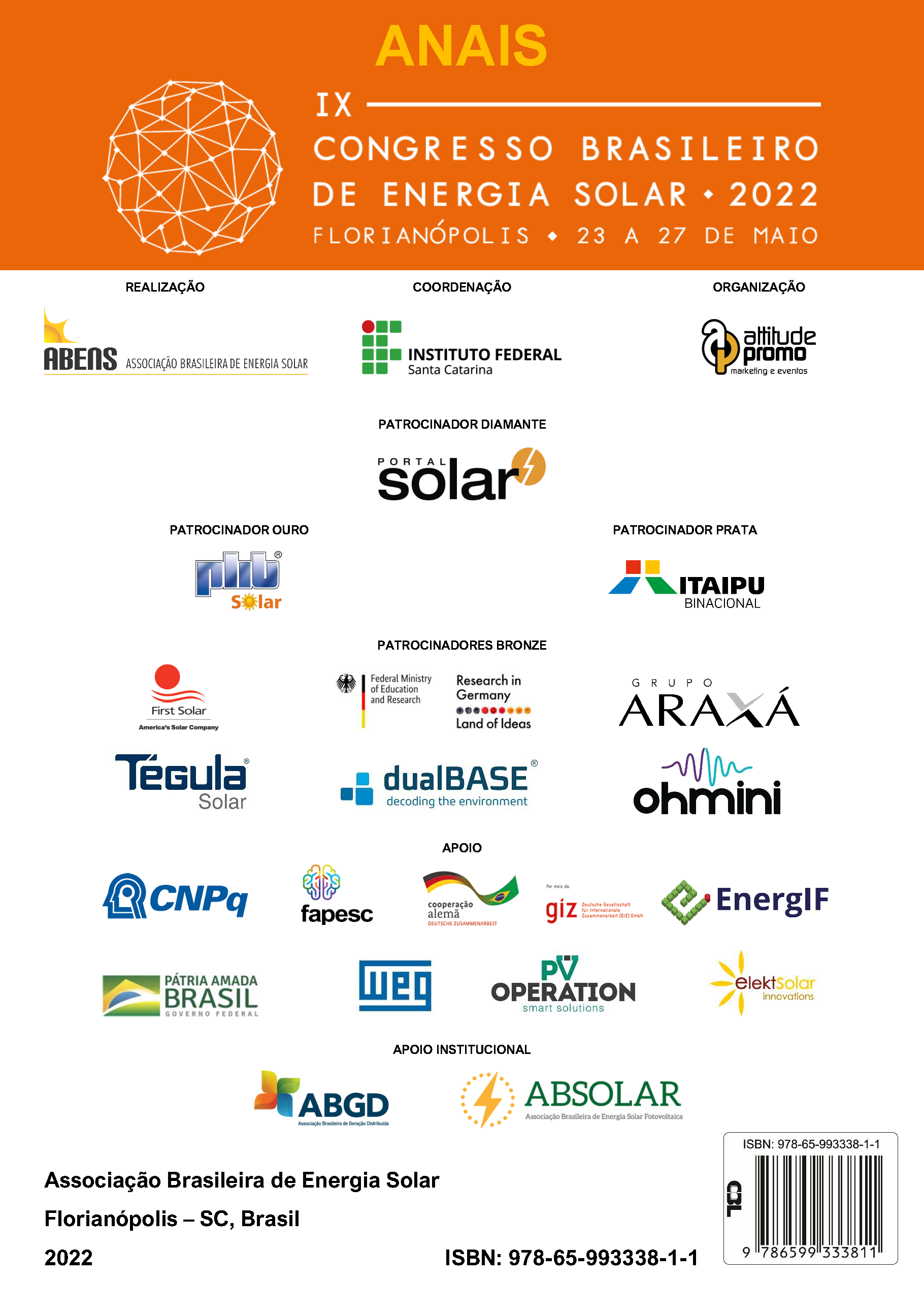PVOASIS
SOFWARE PARA SIMULAÇÃO E ANÁLISE DE SISTEMAS FOTOVOLTAICOS CONECTADOS À REDE ELÉTRICA
DOI:
https://doi.org/10.59627/cbens.2022.1243Palavras-chave:
ferramenta computacional, análise estatística, modelagem e simulação de SFCRResumo
O projeto de P&D Oásis-UFMG, com objetivo de reduzir os gastos com energia elétrica, está instalando no campus Pampulha da Universidade Federal de Minas Gerais uma microrrede de energia com sistemas de geração fotovoltaica, microturbina a gás e armazenamento. Dentro deste contexto está em desenvolvimento, no MATLAB® 2021a, o software PVOasis, uma ferramenta computacional de auxilio as futuras análises energéticas e diagnóstico da GDFV. Para esse desenvolvimento foi realizado, primeiro, o estudo dos modelos matemáticos para estimativa da radiação solar, da geração fotovoltaica e dos inversores. Em seguida foi realizada a implementação dos modelos selecionados para o cálculo da radiação solar no plano horizontal; da estimativa da radiação horaria; da radiação difusa; da radiação em superfície inclinada; dos parâmetros IL (corrente fotogerada), IO (corrente reversa de saturação do diodo) , RS (resistência em série da célula), RSH (resistência em paralelo da célula) e “a” (fator de idealidade do diodo) para caracterização dos módulos fotovoltaicos e da eficiência dos inversores. Por fim a análise dos resultados obtidos com o PVOasis, que permitem dizer que a estimativa radiação horaria ainda precisa ser aperfeiçoada para um resultado mais próximo do observado já que se obteve o MAPE igual a 38,45% e o NRMSE igual a 65,96%, enquanto a estimativa pelos modelos dos módulos foi satisfatória, com o MAPE igual a 12% e o NRMSE igual a 16%, para o cálculo da potência máxima. Os resultados do modelo dos inversores também se mostraram bastante satisfatórios com o MAPE e o NRMSE iguais a 1%, aproximadamente.
Downloads
Referências
Almonacid, F.; Rus, C.; Pérez‐Higueras, P.; Hontoria, L.; Aguilar, JD., 2009. Analysis of the energy produced by a PV generator based on an artificial neural network methodology, Proceedings of 24th European photovoltaic solar energy conference and exhibition, Alemanha.
Alonso Abella, M, Chenlo, F, Valera, P, Enrile, J, and Osmar, R., 2004. V-trough concentrator for low concentration photovoltaic systems; Cavidades tipo V para sistemas fotovoltaicos de baja concentracion, Espanha.
ÅngstrÖm, A., 1924. Solar and Terrestrial Radiation. Quart. J. Roy. Met. Soc. 50, pp. 121‐126.
Araujo, G., Sanchez, E., 1982. Analytical expressions for the determination of the maximum power point and the fill factor of a solar cell. Solar Cells 5, pp. 377–386.
Camani, M., Cerenghetti, N., Chianese, D., Rezzonico, S., 1998. Comparison and behaviour of PV modules. Proceedings of the 2nd World Conference on Photovoltaic Solar Energy Conversion, Vienna, Austria, pp. 2346–2349.
Collares‐Pereira, M., Rabl, A., 1979 The average Distribution of Solar Radiation Correlations between Diffuse and Hemispherical and between Daily and Hourly Insolation Values. Solar Energy, vol. 22, pp. 155‐164.
Desoto, W.; Klein, A.; Beckman, W. A., 2006. Improvement and Validation of Model for Photovoltaic Array Performance. Solar Energy, vol. 80.
Dows, R N, and Gough, E J., 1995. PVUSA procurement, acceptance, and rating practices for photovoltaic power plants.
United States.
Duffie, J. A.; Beckman, W. A.,2013. Solar Engineering of Thermal Processes, John Wiley & Sons, Inc.
Erbs, D. G.; Klein, A.; Duffie, J. A., 1982. Estimation of the diffuse radiation fraction for hourly, daily and mothly- average global radiation, Solar Energy.
Erge, T., Hoffmann, V.U., Kiefer, K., Rossler, E., Heilscher, G.,Schneider, M., Genenning, B.,Rindelhardt, U., Teichmann, G., Blasser, G., Ossenbrink, H., Riess, H., Sprau, P., Decker, B., Grochowski, J., Becker, H., Vaassen, W., 1998. The German 1000-roofs-PV programme – a resume of the 5 years pioneer project for small grid connected PV systems, Proceedings of the 2nd World Conference on Photovoltaic Solar Energy Conversion, Vienna, Austria. pp. 2648–2651.
Fuentes. M.; Nofuentes, G., Aguilera, J.; Talavera, D.; Castro, M., 2007. Application and validation of algebraic methods to predict the behaviour of crystalline silicon PV modules in Mediterranean climates. Solar Energy.
Guisan, O., Schaub, P., Mermoud, A., & Mermoud, A., 1992. PV module characteristics in real conditions. 11th ICPSE. Haeberlin, F. K.; Liebi, C.; Beutler, C., 1995. Results of Recent Performance and Reliability Tests of the Most Popular Inverters for Grid Connected PV Systems in Switzerland, 13th EU PV confrence on Photovoltaic Solar Energy
Conservation,Nice, France, pp. 1–6.
Jantsch, M.; Schmidt, H.; Schmid, J., 1992. Results of the Concerted Actions on Power Conditioning and Control, 11th European Photovoltaic Solar Energy Conference, Montreux, Suiça.
King, D. L., Gonzalez, S., Galbraith, G. M., Boyson, W. E., 2007. Performance Model for Grid‐Connected Photovoltaic
Inverters, Sandia National Laboratory Report, Novo México.
Krenzinger, A., 2001. An Algorithm for PV Array Analysis, Proceedings of 17th European Photovoltaic Solar Energy Conference, Munich. Proceedings of the 17thEPVSEC, Florença, Itália: Mani Fotolito. pp. 816-819. 2001.
Liu, B. Y. H, and R. C., 1960 Jordan. The interrelationship and characteristic distribution of direct, diffuse, and total solar radiation. Solar Energy, Vol. 10, No. 3.
Marion, B., Rummel, S., Anderberg, A., 2004. Current–Voltage curve translation by bilinear interpolation, Progress in Photovoltaics: Research and Applications 12, pp. 593–607.
Mermoud, A; Lejeune, T., 2010. Performance Assessment of a Simulation Model For PV Modules of any Available Technology, Proceedings of the 25th European Photovoltaic Solar Energy Conference, Valencia (Spain).
Page, J., 1964. The Estimation of Monthly Mean Values of Dialy Total Short Wave Radiation on Vertical and Inclined Surfaces from Sunshine Records forL 50N to 40S, New Sources of Energy.
Rampinelli, G. A., 2010. Estudo de Características Elétricas e Térmicas para Inversores para Sistemas FVs Conectados à Red, Tese de Doutorado, PROMEC, UFRGS, Porto Alegre.
Strobel, M. B., Zinsser, B., Makrides, G., Norton, M., Betts, T.R. Georghiou, G. E, Schubert, M., Gottscha, R., 2009. Energy Yield Forecasting for High‐Efficiency PV Systems in Three Location Using Artificial Neural Networks. EUPVSEC-24.
Williams, S.R.; Betts, R.R.; Gottschalg, D.G.; Dunlop, E., 2006. Evaluating the State of the art of Photovoltaic Performance Modelling in Europe. In. Proceedings in 20th EPVSEC, Barcelona.


